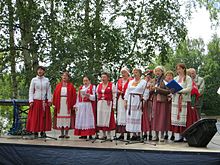Ischoren
The Ischoren or Ingrier (own name: Ingry , Inkeriot , Isurit ) belong to the Finno-Ugrians . They live in the Lomonossow and Kingisepp Rajonen in Leningrad Oblast , the historical region of Ingermanland and Estonia. The population was 820 in 1989. Only 36.8% still spoke the Ischoric language . It belongs to the northern group of the Baltic Finnish languages . The literary language is Russian . The Ischors are Orthodox Christians .
Designations
Occasionally the Lutheran Finns in Ingermanland are also referred to as Ingrier, the names " Ingermanlanders " and " Ingermanland Finns " are more correct for this ethnic group . In Finnish the Ischoren are called inkerikot , the Ingermanlandfinnen inkeriläiset or inkerinsuomalaiset .
history
The izhorians migrated around 1100 from Karelia by Ingermanland , a region around Saint Petersburg around, one where it first in the region of Newazuflusses Izhora settled (Iskera) and native Finno-Ugrians , in particular parts of the Votes integrated. They formed part of the Chudic (Finnish-speaking) population of the Novgorod Principality or the medieval Novgorod Republic . In 1228 the Ischors (Ischora) were mentioned as an area and a tribe in Russian chronicles. With the submission of Novgorod by Ivan III. At the end of the 15th century they came under the immediate rule of Moscow . According to controversial estimates, around 70,000 Ischoren had already turned to the Christian faith in the early 16th century; they belonged to the Orthodox Church . For more than a century, until the end of the Great Northern War in 1721, the land of the Ischors was Swedish . The Evangelical Finns made up the majority of the population in the area at the end of this period. After the Russian (re) conquest, the process of peaceful Russification of the Ishors continued, which also included many aspects of the culture. In 1897 there were still 21,700 Ischoren, by 1926 their number had grown to 26,137.
After the October Revolution in Russia in 1917, a written language was first created for the Ischors, and around 20 books were published by the mid-1930s. Then the written language was abolished and the newly established schools closed. The Second World War represented a serious turning point. Ischors who had fled or evacuated to Finland had to be extradited and were deported until 1956. Since then, external pressure has evidently led to the abandonment of Ischoric identity by the majority of the original Ischoric population. In 1959 their number was only given as 1,026.
literature
- Kari Alenius: Ingrians in the Estonian War of Independence: Between Estonia, Russia and Finland . In: Baltic Security and Defense Review , ISSN 1736-3772 , vol. 15 (2013), issue 2, pp. 5-32 ( online ).
